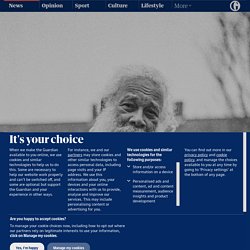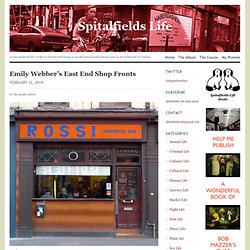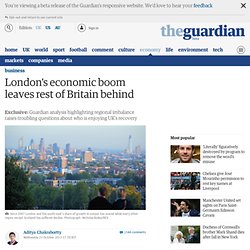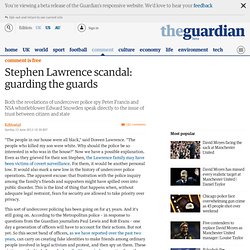

William S. Burroughs' Life In London. 26 Reasons Why Living in London Sucks. Charlie Phillips: why did it take so long for one of Britain's greatest photographers to get his due? Charlie Phillips never planned to become a photographer.

His childhood dream was to be an opera singer, or a naval architect. But then a camera fell into his lap. It was 1958. The 14-year-old had arrived from Jamaica two years earlier and was living in Notting Hill, west London, at that time the first port of call for many Caribbean immigrants. The area was also a destination for African American soldiers stationed at nearby military bases, who didn’t feel so welcome in central London’s white venues. “On Saturdays, if you had a basement flat, you’d move the furniture to one side and make a party,” says Phillips.
That camera became Phillips’s passport to a career that took him across Europe and into contact with notable figures including Jimi Hendrix, Federico Fellini, Muhammad Ali and Henri Cartier-Bresson. This was an era marked by regular racist assaults on the African-Caribbean community, and the 1958 Notting Hill “race riots”. Once upon a time in Hackney: 80s photos of poverty, protest – and partying.
In 2016, Andrew Woodyatt started working at the Rio cinema in Dalston, Hackney, London.

Handed a large bunch of keys, and blessed with a healthy curiosity, he started to explore the Rio’s basement rooms, which had been used for years for storage. Among the broken hoovers and discarded paperwork, he started to come across negatives – local street scenes shot on film strips, which seemed interesting enough to save. Then he hit the jackpot. Opening a rusty filing cabinet, he found 10,000 frames, mounted on glass slides and neatly organised into folders, some with labels such as “NHS”, “Greenham Common” and “Colin Roach”. “I just thought ‘Wow!’”
Under the Influence: John Deakin, Photography and the Lure of Soho by Robin Muir – review. In the emollient climate of today's portrait photography John Deakin's work presents a bracing corrective.

Deakin (1912-1972) photographed celebrities in his heyday, but he never cosseted or flattered them in the manner of a Mario Testino or an Annie Leibowitz. The faces of his sitters, caught in a curious hungover light, loom out at you, bemused, vulnerable, possibly guilty. He called them his "victims", and no wonder. A portrait he took of himself in the early 1950s is revealing, his pinched features and beady gaze suggesting a spiv or a blackmailer out of a Patrick Hamilton novel. "An evil genius," George Melly said of him, and "a vicious little drunk of such inventive malice that it's surprising he didn't choke on his own venom. " Unseen photos of East End London in glorious colour.
A recently discovered photo collection by the late photographer David Granick reveals London's East End in colour, including streets in Stepney, Whitechapel and Spitalfields.

Image copyright David Granick Local photographer Chris Dorley-Brown found the pictures when he was invited to review thousands of Granick's colour slides in early 2017. The discovery led to the release of the book The East End In Colour, 1960-1980, published by Hoxton Mini Press. Granick lived in the East End until his death in 1980 at the age of 68. His photos bring to life a past that was predominantly documented in black and white. Blowup: in search of the swinging London locations. On the hottest day of the year I decided to reassemble London.

This was the London cut-up and edited in the most William Burroughs of ways by Michelangelo Antonioni in his 1966 film Blowup, which first came out in cinemas half a century ago. Antonioni’s film defines a very particular period in British cinema and, in its presentation of London, creates a fictional realm detailing the modern day and its eccentricities. The choice of locations that the director uses to portray his swinging London provides some of the most visited of British film locations, and the sheer volume of different roads, buildings and areas used to create the London collage suggests a lot about Antonioni’s own method of filmmaking, augmenting real locations until they suited his own needs.
Colours, buildings and even trees are edited until they match the reality within. Walking-tube-map. London Underground in the 1970s/80s. George The Poet.
Trudge london - Bruce Davidson, Capturing The City. Some photography now from Magnum’s legendary Bruce Davidson.

Emily Webber’s East End Shop Fronts. Hanbury St, E1 Ten years ago, Emily Webber began photographing London Shop Fronts and now she has collected more than fifteen hundred fine examples across the capital, from which these East End favourites are selected.

“I was initially fascinated with the fonts, but after a step back I started to look at the whole picture,” Emily explained to me, “I choose shops that look like they have a story to tell. I look for clues — worn signage or a sign that is half written-over, a tile design, any mark of individuality. These premises are the overlooked backdrop to our city and already a fair few have gone or changed their appearance.” MixBit. Look_upLondon : Ceramic tiles on the side of... The Economist explains: Why are there so many tunnels under London? London's economic boom leaves rest of Britain behind. London's economy is doing even better after the banking crash than during the bubble – while nearly every other part of the UK has seen its economy shrink by comparison.

Exclusive findings published by the Guardian show that London and the south-east are racing away from the rest of the UK at a pace that would have seemed almost incredible at the height of the financial panic. During the boom from 1997 to 2006, London and the south-east was responsible for 37% of the UK's growth in output. Since the crash of 2007, however, their share has rocketed to 48%. Every other nation and region – with the exception of Scotland – has suffered relative decline over the same period.
Why Frieze art fair reflects London all too well. If you doubt that London is the capital city of the global oligarchy, look around.

When Russian, Kazakh or American billionaires buy mansions, the government ensures they pay minimal property and foreign earnings taxes. Geoff Stern Underground Full 4 minute version HD. Fabulous film footage of #London in 1951. 1960's #bellydancer on the #London Ungerground. I ... Stephen Lawrence scandal: guarding the guards. "The people in our house were all black," said Doreen Lawrence.

"The people who killed my son were white. Why should the police be so interested in who was in the house? " Now we have a possible explanation. Even as they grieved for their son Stephen, the Lawrence family may have been victims of covert surveillance. For them, it would be another personal low. This sort of undercover policing has been going on for 45 years. It was not only the women and the children fathered in these duplicitous relationships who have been harmed. London 1927. Murder most ordinary – in pictures. Ghosts on the Underground. Jummy_Cliff : PHOTO: Portrait of a Girl.
Dark City: London in the 30s « The Library Time Machine. There was another London, before clean air, before the Blitz, before post-war reconstruction. It was a night time London. It was a city of alleys lit by dim lamps. Grand but mysterious arches leading to dark halls and obscure institutions. Secret squares. Forbidding locked doors in isolated precincts Deserted paths. Cyclopean columns. Deserted back streets.
Gardens you should never enter. Cul-de-sacs in which someone is waiting for you. Dark alleys, barred windows. Made in Shoreditch - A Magazine About Style, Innovation, Dining, Nightlife and People in Shoreditch. Patrick Keiller on London: read the original interview. "Do you know that Zola once lived in Crystal Palace, Rimbaud off Tottenham Court Road? " asks Patrick Keiller , assigning parts of London to dead writers, like a cabbie versed in French Literature. Keiller is the writer/director of a beguiling new film on the capital, called, economically enough, London.
Not your bacon rolls and Woodbines fare, his film is rather more concerned with tracing the city's cultural past, especially its French Connection. If this makes the film's brow seem forbiddingly high, don't worry: it soon slips. 24 hour licence: a 24 hour milk bar in Bear Street, just off Leicester Squa. Guardian Artangel books podcast: Teju Cole. Where are you from originally. Embed Code options.
John Perivolaris. How Qatar is taking on the world. On Thursday evening Sheikh Hamad bin Jassim al-Thani, who combines the roles of Qatar's prime minister and foreign minister, stood with the Duke of York and mayor of London, Boris Johnson, to watch the inauguration of the Shard. David Bailey. Public Space. Anders Petersen explores the once raw and sleazy underbelly of London. JDP. Nick Papadimitriou. Photography back in the frame at Tate. It was not until 2003, with the exhibition Cruel and Tender that photography entered the exhibition programme in a significant way. Whereas the Museum of Modern Art in New York had been collecting photography since the 1930s and the Centre Pompidou in Paris, since the 1980s, Tate began late, but it has catching up with enthusiasm. Between 2007 and 2010, the gallery reportedly spent £1.5 million on works by a variety of photographers, from Robert Frank to Taryn Simon.
Polpetto - Upstairs at The French House.
China Miéville. How well do you know your cockney rhyming slang? Dérive App 'urban exploration app' London 2012. Seventies London.